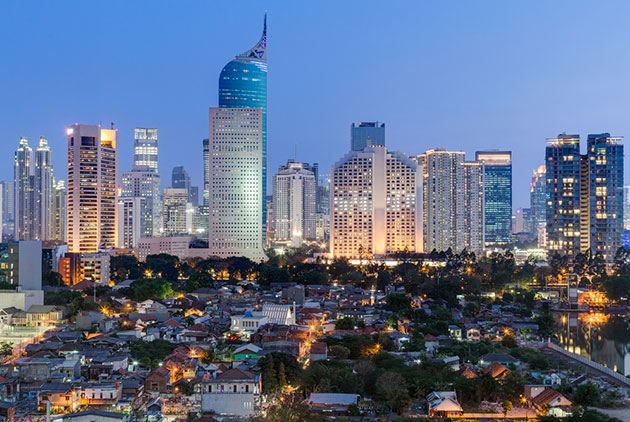The Host of 2018 Asian Games 'Sinking'
Jakarta Is One of the World's Fastest Disappearing Cities

Source:Shutterstock
Jakarta, the host of the 2018 Asian Games (Jarkata Palembang 2018), is now in Asia's spotlight. The large city has been growing, developing...also sinking. The rising sea level caused by climate change is threatening the city's future.
Views
Jakarta Is One of the World's Fastest Disappearing Cities
By Sean Flemingweb only
On the north west coast of the island of Java lies the Indonesian capital Jakarta, one of the world’s largest cities. It is also one of the world’s fastest disappearing cities.
The land Jakarta sits on is swampy. This is mostly because there are 13 rivers flowing through it. The city lies in a low, flat alluvial plain with an average elevation of just 8m above sea level. It routinely floods and Jakarta is sinking at an alarming rate. The extent of the sinking is such that many of those rivers flowing through the city have to flow uphill to reach the sea, often disgorging their contents before they get there.
The Greater Jakarta area, home to almost 30 million people, has sunk by 4m in the last 30 years. The situation is worst in North Jakarta, one of the city’s five districts, which has sunk by an alarming 2.5m in the last 10 years alone. That’s twice the global average for coastal megacities. At that rate, 95% of north Jakarta will be underwater by 2050, directly impacting 1.8 million of the city’s 10 million people.
Water, Water Everywhere...
Sitting as it does on the shores of the Java Sea, one of the problems facing Jakarta is the phenomenon of rising sea levels. NASA has been tracking sea levels via satellite since 1993. It has detected a rise of around 85mm in that time and an increase of 3.2mm per year at current rates.
Far away from Jakarta, climate change has led to permanent loss of ice at the poles. Glacial meltwater is pouring into the oceans as ice sheets diminish. The oceans are also getting warmer, and as warm water is not as dense as cold water, the seas are expanding and therefore rising. In some parts of the world, regional climate events such as El Niño in the eastern tropical Pacific, are exaggerating some of these effects, too. Complex global currents also have a part to play, with melting ice in Greenland possibly disrupting the Gulf Stream that flows from the Gulf of Mexico across the Atlantic toward the British Isles.
 Rising sea levels are being monitored by NASA satellites (Image: NASA)
Rising sea levels are being monitored by NASA satellites (Image: NASA)
... But Not a Drop to Drink
Despite living surrounded by water, the people of Jakarta don’t have access to a reliable supply of clean, piped water. Instead, water has been pumped from aquifers deep below ground – aquifers that are not being adequately replenished by rainfall.
The net effect of this is that the ground beneath the city is compacting and collapsing. In some parts of the capital a seawall is all that stops streets and houses from being consumed by the rising waters. Whole hillsides have been claimed by the Java Sea and people who once had to walk to the ocean now live uncomfortably close to it, with almost half the city now below sea level.
Some of the underlying aggravating factors that contribute to this unsustainable situation might also be part of the solution, however.
The problem of water extraction is caused by the absence of a reliable water supply, but permitted by regulations that allow private citizens and businesses alike to dig their own wells at will. The unlicensed and unregulated access to groundwater allows demand for water to grow unchecked, and does nothing to tackle the problem of over-consumption or waste water run-off. It is one of the things the city authorities will need to face up to.
There are also enormous pressures on the land, as developers build and redevelop streets and neighbourhoods to keep up with the demand for property, which is furthering the demand for water.
Work has begun on flood protections some 32km out to sea. The new defences will create an artificial lagoon for the rivers to flow into, as well as functioning as a seawall. This will mitigate some of the flooding. But any solution to Jakarta’s sinking problem needs to take all contributing factors into consideration and deal with them coherently. Building seawalls will only ever buy time for a city sitting on land being allowed to collapse further and further below sea level.
Jakarta needs an injection of investment to modernise its infrastructure, in particular to provide a reliable and sustainable water supply for its inhabitants, and a vision for its future built on the cooperation of authorities, business, and private citizens alike.
Edited by Shawn Chou
Additional Reading
♦ Taiwan: The Water-starved Island
♦ The Night Jakarta Burned
♦ We Have the Tools to Fight Climate Change. It’s Time to Start Using Them
Original content can be found at the website of World Economic Forum.
♦ Jakarta is one of the world's fastest disappearing cities
This article is reproduced under the permission of World Economic Forum (WEF) and terms of Creative Commons Attribution-NonCommercial-NoDerivs 4.0 Unported License (“CCPL”). It presents the opinion or perspective of the original author / organization, which does not represent the standpoint of CommonWealth magazine.







